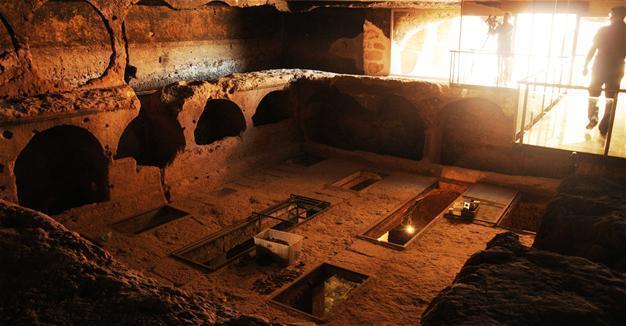Graves of Mardin’s ancient city to open visitors
MARDİN – Anadolu Agency
 A gallery grave, unearthed during archaeological excavations in the ancient city of Dara in the southeastern Turkish province of Mardin eight years ago, will be opened to visitors.
A gallery grave, unearthed during archaeological excavations in the ancient city of Dara in the southeastern Turkish province of Mardin eight years ago, will be opened to visitors. The gallery grave (a form of megalithic tomb), where hundreds of people were buried together, and where reinvigoration ceremonies took place in the Roman era, was unearthed in the 2009-2010 excavation season in the central Artuklu district.
The “Dara Gallery Cemetery Relief, Restitution and Restoration Project” was then approved by the Diyarbakır Cultural and Natural Heritage Preservation Board, and since then works have been carried out by the Mardin Museum Directorate.
The museum is set to finish the excavations and restoration this season in the necropolis area, the quarry, the front of the western cistern, the cemetery and the gallery grave, before opening them to tourists.
With the opening of these fields, visitors will be able to see the area of reinvigoration ceremonies held in the 6th and 7th centuries in the Roman era.
Mardin Museum Director Nihat Erdoğan said the Romans established the Dara ancient city in 507 A.D. as the military headquarters. He said they had been working in the cemetery of the ancient city since 2009, restoring and making environmental arrangements there.
“This is a cemetery used in the 6th and 7th centuries. There are the bones of people who believed that they would resurge. Excavations have unearthed lots of human bones,” Erdoğan said.
He added that with the Dara ancient city tourism infrastructure project, which also receives support from the Dicle Development Agency, the gallery graves, where these ceremonies took place, had been closed behind protective glass and walking routes were created for visitors.
He said the area, which served as a cemetery for 1,500 years, was a significant value for tourism.
“Six archaeologists, four restorers and two anthropologists are working here. We have found candles, water bottles and tear bottles, which were put in graves in the pagan era. These finds will also be displayed at the museum. We will keep the skeletons in the cemetery in their original place and they will not be removed.
Visitors here will have a chance to see the rituals here in the ancient ages,” Erdoğan stated.
Unique in the world
“The scenes featuring people collecting bones for reinvigoration ceremonies were depicted at the entrance gate. This may be seen on the walls or ceilings of some churches and other structures. But in this place, you can see the bodies buried and the reliefs together. This is unique in the world,” he said.
The ancient city is planned to be opened to tourists at the end of this year.
“At the end of March we will open previously unseen places. Dara is becoming richer as it is excavated and returning to its original self. We invite everyone to see this place,” Erdoğan stated.
















